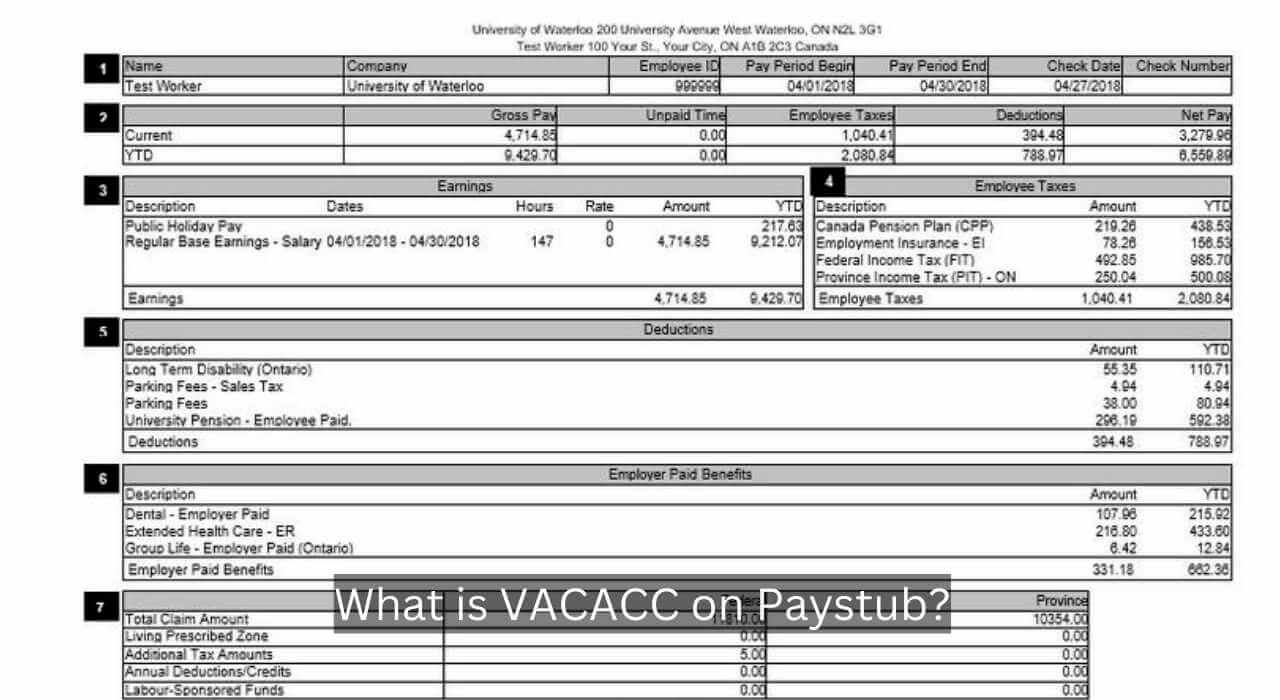Understanding vacation time on your pay stub: VACACC explained
Understanding how to read check stub and also vacation time on it is essential to track how much time off you have earned and when you can use it. In this article, we'll explain what vacacc is and go over how to read vacation time on your pay stub so that you can make the most of your time off.
What is Vacacc on Paystub?
Vacacc on a paystub is an abbreviation for vacation accrual. It tracks the vacation time an employee has collected and can cash in. The employee earns this vacation over some time. And it’s usually in hours or days and is listed on the pay stub.
Knowing how much vacation time you have earned is essential to ensure you take full advantage of it. Vacation accrual may also refer to the amount of time that can be carried over from one year to the next if your employer allows it. Knowing the available vacation time is vital in planning your time off work.

What is a PTO Balance on a Pay Stub?
A Paid Time Off (PTO) balance on a pay stub accounts for the total amount of PTO that an employee has earned but has yet to take. This balance is updated each payroll cycle and typically includes vacation days, sick days, and any other paid time off that the employee has available.
Companies use this information to track how much PTO each employee has accrued, so they can manage their personnel expenses and plan for future staffing needs. They may also use PTO balances to determine whether or not an employee is eligible for a salary increase or bonus.
How to Read the Vacation Balance on a Pay Stub
First, locate the section of the pay stub that is labeled "Vacation Balance." This section will typically list the number of vacation days an employee has available and the number of vacation days they have taken in the current year. Or, you can get more details by finding vacation and sick hours with Quickbooks.
Calculate Vacation Pay
Generally, companies calculate vacation pay by multiplying the employee's average weekly wage over the last four weeks by the number of vacation days taken. Employers determine the average weekly wage by adding the employee's gross wages over the previous four weeks. And then dividing by four. The resulting number gives you the weekly average wage you can then employ to ascertain the amount of vacation pay due.
Additionally, if there are any amounts listed as negative numbers. In that case, this indicates that the employee has gone over their allotted vacation days. And may need to make up the difference when they return to work.
Example
For example, if an employee has taken three vacation days. And their average weekly wage over the last four weeks was $500. Then their vacation pay would be $375 (3 days x $500 = $1500/4 = $375).
It is important to note that vacation pay is not necessarily the same as regular wages. Most employers will include a certain percentage of vacation pay in addition to the regular wages earned over the last four weeks. This percentage can vary from employer to employer, but it is generally between 4-6%.
Frequently Asked Questions (FAQ)
-
What does VAC mean on a pay stub?
VAC stands for vacation pay on a pay stub. It is the amount of money an employer pays an employee to cover the cost of taking time off from work for holidays or other personal reasons. Employers usually calculate vacation pay as a percentage of the employee's earnings. And this is over a specified period and is generally in addition to the employee's regular wages.
-
How is vacation pay calculated for salary employees?
Employers calculate vacation pay for salary employees depending on the number of hours they have worked in the year. Generally, most salaried employees receive two weeks of vacation pay per year. Thus, their vacation pay calculation will be a percentage of their total annual salary. Additionally, the laws in certain states and jurisdictions may require employers to pay out unused vacation pay when the employee leaves the company. For more information, you can check out how to calculate adjusted gross income from pay stub.
-
What is a vacation accrual memo deduction?
Vacation accrual memo deduction reduces an employee's accrued vacation time from their overall total. And this typically happens when an employee uses only some of their allotted vacation days in a given year. Or if the employer overpays an employee in vacation hours due to an error in tracking. In either case, the employer will deduct the overpaid vacation time from the employee's overall vacation accrual balance and calculate the paycheck with deductions. The employer should note the deduction in a memo sent to the employee, which is typically recorded in the payroll system.
-
How does vacation accrual work?
Vacation accrual is a system many companies use to track the amount of paid time off (PTO) an employee has earned but has yet to use. Under this system, employers track the number of vacation days accrued by each employee over the year. Usually, by calculating the amount of PTO, an employee has earned based on the number of hours they've worked. Depending on the employer's policy, employees may be able to carry some unused vacation days into the following year.
-
How do I calculate vacation accrual?
Depending on your company's policies and goals, you can calculate vacation accrual using several methods. The most common method is an accrual rate. And this is the rate at which an employee earns vacation days. The rate typically depends on the number of hours employees work in a given period. For example, if the accrual rate is two days per month, an employee who works 40 hours per week for four weeks would receive eight vacation days at the end of the period.
Kristen Larson is a payroll specialist with over 10 years of experience in the field. She received her Bachelor's degree in Business Administration from the University of Minnesota. Kristen has dedicated her career to helping organizations effectively manage their payroll processes with Real Check Stubs.

